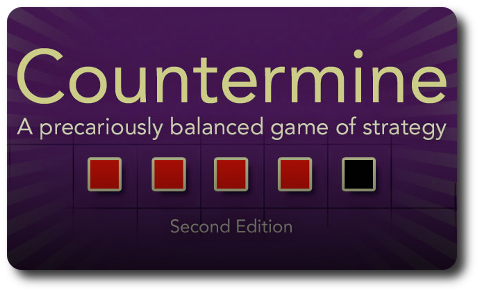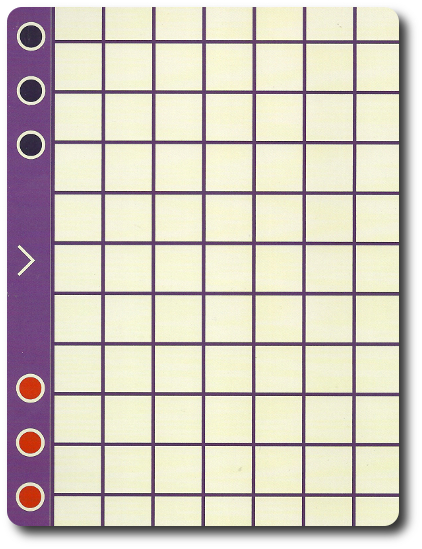
The Basics:
- For ages 6 and up (publisher suggests 12+)
- For 2 players
- Approximately 45 minutes to complete
Geek Skills:
- Counting & Math
- Logical & Critical Decision Making
- Pattern/Color Matching
- Strategy & Tactics
- Bluffing and Misdirection
Learning Curve:
- Child – Easy
- Adult – Easy
Theme & Narrative:
- Victory can only be achieved through proper placement and good timing
Endorsements:
- Gamer Geek rejected!
- Parent Geek mixed!
- Child Geek approved!
Overview
Professional tennis player, Jo Durie, said “If you can defend, counter-attack and take the initiative, then you become a more dangerous player.” In this game, every time an opponent gets the advantage, it can lead to an even bigger advantage for the player. The trick is setting yourself up for the big win and hoping your opponent doesn’t see through your ruse.
Countermine, designed by Alan Dyck and published through the Game Crafter, is comprised of 1 game mat, 80 small cubes (40 red, 40 black), and 5 white rings. The game mat is made of card stock and can easily be creased or warped. The rings and cubes are made of plastic and are very durable.
Game Set Up
To set up the game, first place the game mat in the middle of the playing area. Have the players sit opposite of each other and orientate the game mat so each player has 3 dots facing them on either their left or right side.

Second, give each player all 40 cubes that match the same color as the closet set of dots on the game mat.
Third, place the rings off to one side of the game mat.
That’s it for game set up. Determine who should go first and begin.
Counter, Block, and Score
The game mat is made up of 12 rows and 12 columns, creating a 12×12 square grid. The game mat starts empty, but as the game is played, will begin to fill up with the players’ cubes. Starting with the first player and continuing in turn order sequence, each player will take the following actions on their turn.
Step 1: Place One Cube
The player takes 1 cube of their color and places it anywhere on the game mat where there is an empty space. Only 1 cube per space and all cubes must remain in the 12×12 square grid area.
Step 2: Check for Score
A player scores if they create a row of 5 or more cubes of their color. The row could be horizontal, vertical, or diagonal. The player then takes 1 ring and places it around 1 of the 3 dots of their color. This indicates the player has earned 1 point.
Regardless if the player scored or not, their turn is now over.
The Reactionary Bonus Action
When an opponent scores a row comprised of 5 cubes, the player gets a bonus action during their turn. First, they take 1 of their yet to be played cubes and place it on the arrow that divides the player dots on the game mat. This cube will be used later on the player’s turn.
Second, the player takes another of their yet to be played cubes and swaps it with any cube that was part of their opponent’s scored row. The player’s cube remains, but all the cubes that belong to the row that helped score are now removed from the game mat and returned to the opponent.
Now the player takes their turn as normal, using the cube they placed on the arrow.
An opponent does not get a reactionary bonus action if the scored row is comprised of more than 5 cubes.
Chain Reactions
It’s possible that reactionary bonus actions and the player’s normal turn create one or more scored rows. To help keep track of the extra actions, players should immediately place a cube on the arrow when they earn one. This will help everyone in the game count the extra turns and keep track of multiple scoring.
If a single cube scores more than 1 row at a time, the opponent only gets 1 reactionary bonus action.
Winning the Game
The first player to score 3 points wins the game. The game immediately ends, stopping the opponent from scoring any additional points with a reactionary bonus turn.
The game can also end if a player is unable to place any cubes due to all of them being in play already. If such is the case, the player with the most points wins the game.
To learn more about Countermine, visit the game’s website.
Final Word
The Child Geeks enjoyed the game, finding it to be similar to Connect Four. They really liked the reactionary bonus turn that allowed them to take advantage of their opponent’s good fortune to improve their own position. According to one Child Geek, “What I like most about this game is the ability to place your cubes anywhere. This lets me work on different rows all at the same time.” Very true and it’s fun to attempt to score using multiple rows, but a player can quickly get themselves too thinned out. As one Child Geek put it, “I can’t decide if it’s best to be all over the board or focus on a corner. Either way, I like the game.” When the cubes were put away, all the Child Geeks voted to approve Countermine.

The Child Geeks had a good time – well not when losing, but that’s to be expected
The Parent Geeks liked the game, too, but were disappointed that it was only for 2 players (editor’s note: a team of 2 versus 2 is possible, but we didn’t have the rules). As one Parent Geek put it, “I think the game would be better if 4 players could join in on the fun. For what it is, I think it’s OK. Not great. Just OK.” Countermine failed to “wow” the Parent Geeks, but nor were they disappointed. According to one Parent Geek, “The game is solid enough. No complaints there. It’s just not very imaginative and fairly boring after a bit.” When the games were over, the Parent Geeks found that they enjoyed Countermine with their children, but the game itself was fairly forgettable. They decided to give it a mixed level of approval as a result.
The Gamer Geeks were not impressed. According to one Gamer Geek, “I don’t see much originality in this game, I think it is poorly made, and isn’t very interesting to play.” None of the Gamer Geeks found the game to be broken, but none of them found the game to be of any interest, either. As one Gamer Geek put it, “If a game doesn’t draw me in, allow me to enjoy myself, and have a good time, it is a total failure.” The Gamer Geeks did not approve Countermine, finding it to be a game that lacked originality or entertainment.
Countermine is similar enough to other games that it’s easy to teach and easy to play. These are what I would consider real boons. Unfortunately, others will find the same boons to be banes. Which was the case with the Gamer Geeks. The Parent Geeks didn’t think the world of Countermine, either, but enjoyed the game play enough to approve it. It was the Child Geeks, those with the least amount of experience, that enjoyed the game the most. This leads me to believe that older and more experienced gamers are jaded individuals. Especially when it comes to playing games that have a great deal in common with other games.
So be it.
What must be taken into account is the game itself, not how others “feel” about it. Subjectively, the game didn’t warm many over. Objectively, the game is solid. It does exactly what it was designed to do, but not in a way that struck others as interesting. This leaves us with a game that plays very well, but won’t get to the table often. A pity, as Countermine is challenging when playing with someone who wants to win just as badly as you do. This is a game of substance, but of little interest.
If you enjoy Abstract Strategy games, then Countermine might be for you. I recommend it for younger players, however. Older and more experienced players won’t be satisfied with the game’s depth of play.
This game was given to Father Geek as a review copy. Father Geek was not paid, bribed, wined, dined, or threatened in vain hopes of influencing this review. Such is the statuesque and legendary integrity of Father Geek.
Discover more from Father Geek
Subscribe to get the latest posts sent to your email.





